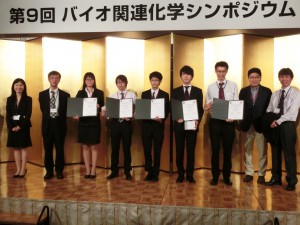Congratulations to the Poster Prize winners at the 9th Symposium on Biorelevant Chemistry.
We were please to present the prize to these winners:
- Ayaka Nakashima (Nagoya University)
- Kotaro Nishiyama (University of Tokyo)
- Hayato Kawai (Nagoya University)
- Takeya Shou (Tokyo Institute of Technology)
- Takayuki Miki(Kyoto University)
Organized by the Chemical Society of Japan, the Biorelevant Chemistry Symposium took place from 10-12th Sept in Kumamoto, Japan.
From left to right: Professor Rie Wakabayashi (Poster award committee co-chair), Professor Hiroyuki Asanuma (Poster award committee chair), Ayaka Nakashima, Kotaro Nishiyama , Hayato Kawai , Takeya Shou , Takayuki Miki, Professor Masahiro Takagi (Chair of the Division of Biotechnology, Chemical Society of Japan), Professor Itaru Hamachi (Vice-Chair of the Division of Biofunctional Chemistry, Chemical Society of Japan).













